
Out of all the water shoes we tested, these are our top picks for 2025. Photo: Steve Andrews//The Inertia
It’s no secret that we at The Inertia love being in the water. However, there is a wide spectrum of footwear claiming to be water shoes. Some are better suited to your individual purpose than others. We’ve been testing a range of options across shorelines, rivers, and lakebeds, and we have settled on the best water shoes for every type of aquatic adventure. Check out our favorites below.
Navigate To: Comparison Table | Buyer’s Guide | How We Tested
Related: Best Women’s Water Shoes | Best Men’s Sandals
Editor’s Note: We updated this guide in November 2024 with improved navigation and new top picks. We temporarily had to remove our former top pick, the Salomon Techamphibian 5 (buy here), because it was no longer in stock, but it looks like it’s back, so we’re updating this guide again to reflect recent testing.
The Best Water Shoes of 2025
Best Overall Water Shoes: Danner Rivercomber
Best Budget Water Shoes: Crocs Classic
Best Water Shoes for Hiking: Hoka Hopara 2
Best Water Shoes for Swimming: Xero Aqua X Sport
Best Recovery Water Shoes: Kane Revive
Best Casual Water Shoes: Olukai Moku Pae
Best Overall Water Shoes
Danner Rivercomber ($160)
Upper Material: Nylon
Sole: Vibram Rivercomber
Closure: Laces
Pros: Lightweight, grippy sole, versatile
Cons: Pricey
Danner is more well-known for its hiking boots and trail-ready footwear. But when we heard of its water shoe offering, The Rivercomber, we had faith that the shoes would live up to their land-borne brethren. And sure enough, Danner made a quality pair of shoes that will hold their own on land yet shine underwater. The shoes are lightweight and quick-drying at 22 ounces for a pair. But they are still rigid enough to provide support on wet rocks and uneven terrain. The Vibram outsole provides exceptional grip on wet surfaces thanks to a pattern meant to push water away. And since their soles are non-marking, the Rivercomber works great as boat shoes as well.
The Rivercombers work well in a variety of situations, offering comfort, stability, and quick-drying materials that will last. It was enough for us to give it the nod for our favorite water shoes after our former top pick, the Salomon Techamphibian, went out of stock.
Check Price on AmazonBest Budget Water Shoes
Crocs Classic ($50)
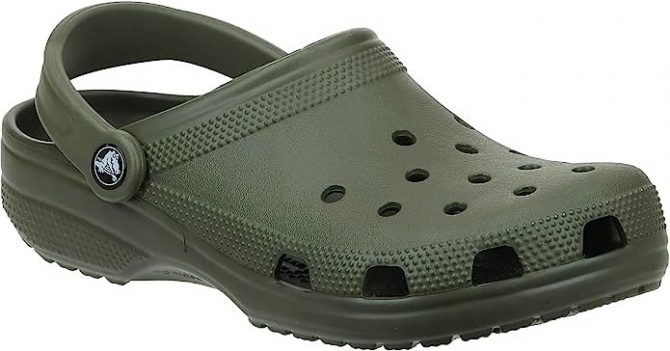
Upper Material: Croslite (oil-based)
Sole: Croslite (oil-based)
Closure: Slip on
Pros: Affordable, lightweight, and comfortable
Cons: Not very durable, can get sweaty in the sun
Crocs. People either love ’em or hate ’em, and the haters usually haven’t tried ’em. So take it from us — Crocs Classic clogs are still well-performing water shoes. And in the case of “what’s old is new again,” they seem to be back in style across the world.
These clogs are lightweight, buoyant, easy-draining, and remarkably comfortable. And with a price tag that could have you buying a few pairs for less than a night out on the town, it’s a worthy investment. All we have to say is this: Before you knock ’em, try ’em.
Check Price on Backcountry Check Price on Amazon
Best Water Shoes for Hiking
Hoka Hopara 2 ($135)
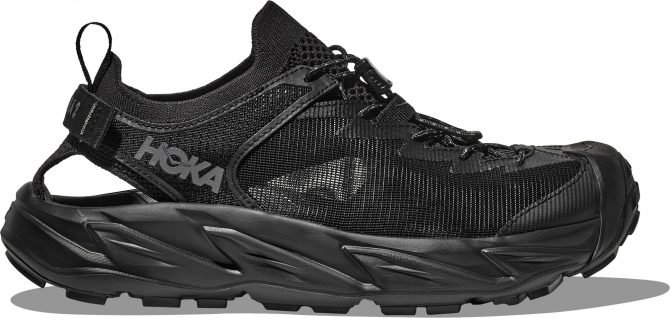
Upper Material: Synthetic/Neoprene
Sole: Rubber
Closure: No-tie laces
Pros: Excellent traction for different types of terrain, quick-drying and water-friendly materials
Cons: Sole may be too springy for some, unique style isn’t for everyone
For the hiker who loves exploring wet and challenging terrain, Hoka Hopara 2 is the perfect companion. These shoes offer exceptional traction on various surfaces, allowing you to navigate through unpredictable trails with ease. Their lightweight and breathable design ensures maximum comfort and ample drainage. We found their soles to be durable yet flexible. And with Hoka’s well-renowned cushioned midsole, you’ll be able to log plenty of miles, whether wet or dry, with happy joints the whole time. We tried both the original Hopara and the newly redesigned Hopara 2, which was a significant upgrade. The new shoes feature Cordura material that dries much faster, as well as mesh to keep unwanted debris away from your feet.
Hoka Hoparas are water shoes that look like water shoes, so their versatility is a bit limited. They aren’t going to impress at a post-paddle cookout. But if you value performance over style, then you’ll be impressed with the function and fit of Hoparas. The shoes come in a variety of colorways, and while we tested the white version, found that they were a bit too attractive to dirt, so would opt for a darker color if you indeed want to take them hiking.
Check Price on Amazon Check Price on Hoka
Best Water Shoes for Swimming
Xero Aqua X Sport ($130)
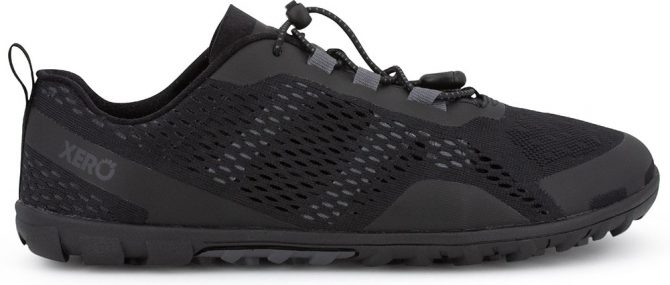
Upper Material: Polyurethane
Sole: Rubber
Closure: Quick-pull laces
Pros: Designed for optimal performance in water sports, excellent grip and flexibility, quick-draining and lightweight
Cons: May not provide sufficient protection for certain activities, limited insulation for colder water
If you need extra mobility in the water without sacrificing good traction, Xero Aqua X Sport water shoes are the ideal choice. These shoes are specifically designed to excel in water sports activities, with a close fit that won’t come loose but stays on the foot through all the trials and tribulations of underwater movement.
Their lightweight and flexible construction is a hallmark of Xero Shoes’ design philosophy. The enhanced maneuverability allowed us to push our limits when testing. We also found these shoes performed great when we had to swim, as they didn’t bog us down with heavy material underneath. When it came time to stand up, the shoes had plenty of sole thickness to protect the feet while still providing ground feedback.
Out of the water, they felt supportive and comfortable despite the low profile. We probably wouldn’t want to take them on any huge hikes. But if a scramble was necessary to get down to the waterline, these wouldn’t put up too much of a fuss about it. Running was also surprisingly comfortable, both on the road and on the trail. However, near the water is where they truly shine.
Shop Men's on REI Shop Women's on REI
Best Recovery Water Shoes
Kane Revive ($75)
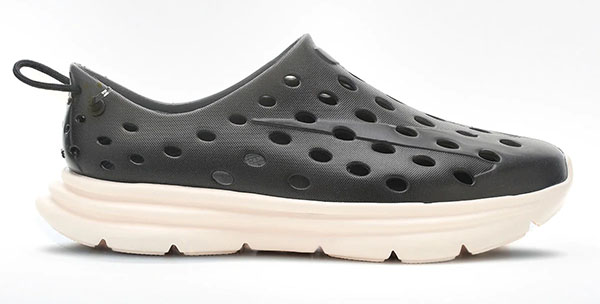
Upper Material: Sugarcane-based foam
Sole: Sugarcane-based foam
Closure: Slip-on
Pros: Great support, sustainable materials
Cons: Loose-fitting, not meant for active pursuits
Kane is an aptly named company. Its shoes are made from sugar cane, a resilient and hearty plant that is as renewable as it comes. It’s hard to tell the difference between Kane’s foam and its petroleum-based counterpart. That makes us ask the question, “Why don’t more companies do this?” The brand’s flagship offering, the Revive, has the potential to be a game-changer for people wanting to baby their feet.
The footbed was among the most comfortable we tried. Little bumps on the insole help stimulate circulation. And with a plentiful hole pattern to help with breathability and drainage, it’s the perfect option after a big day. The Revive is like an athletic version of Crocs with better traction. We wouldn’t choose the Revives for big missions as the uppers aren’t the most supportive. But Kane doesn’t pretend they are anything but recovery shoes. In that case, the Revives are a wise choice for tired feet.
Check Price on dicks sporting goods
Best Casual Water Shoes
Olukai Moku Pae ($120)
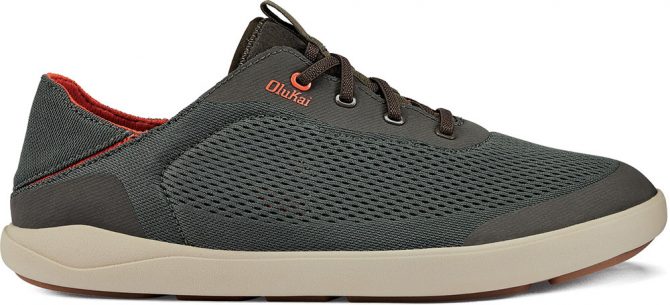
Upper Material: Engineered mesh
Sole: Rubber
Closure: No-tie laces
Pros: Unbeatable, long-lasting comfort, superior water resistance and quick-drying capabilities
Cons: Takes a while to dry out, especially when wearing them
We should probably mention right off the bat that Olukai classifies its Moku Paes as “boat shoes” and not water shoes in the traditional sense of the word. They are meant to handle light splashes more than full submersion. If you want shoes that look great, feel great, and can withstand getting wet from time to time, these might be the right choice for you.
These shoes felt comfortable immediately. The no-tie laces still keep the foot secure and have a look that calls to mind the sax solo of Gerry Rafferty’s “Baker Street.” Whether or not you’re a Yacht Rock aficionado is beside the point, the comfort you feel with these shoes on will have you vibing. No, they aren’t performance shoes. But quality footwear you can rock without socks and get wet without ruining your day? Absolutely.
Unfortunately, they’re not available in women’s models, but Olukai does have plenty of women’s styles to choose from.
Check Price on REI Check Price on Backcountry
Best of the Rest
Best Water Shoes For Kids
Native Jefferson ($22)
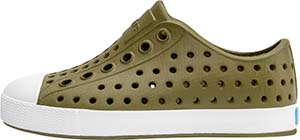
Upper Material: EVA
Sole: Rubber
Closure: Slip-on
Pros: Lightweight, quick draining
Cons: May lead to blisters if too tight
Kids need water shoes too, and when you think about it, probably more than adults. As they romp around the shoreline they aren’t really worried about what might get in their way, and cutting one’s feet on some debris will be a fast end to a fun day in the water. Native shoes have scaled down their popular Jefferson model to a bite-sized version, ready for whatever comes their way on land or in the water.
With sizes that go down to 5T, even those just learning to walk will have some protection underfoot in shoes that are quick-drying, easy to put on, but hard for little ones to take off. So whether you have kids of your own or need a good gift for a grom-in-training you know, these shoes are long-lasting and ready for several generations of hand-me-downs.
Check Price on AmazonBest Wet Shoe
NRS Kicker ($58)
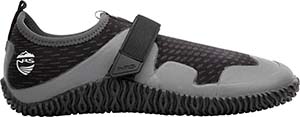
Upper Material: 3 mm neoprene
Sole: Rubber
Closure: Velcro strap
Pros: Warm, nimble, good traction
Cons: Looks silly wearing on land
There is a time and place for a wet shoe. That time and place is when you’re on the water more often than land in any given day. Paddling is probably the best use case, and one of the top river sports companies has our pick for the best-wet shoe. Using a simple design of neoprene to keep you warm and a tough rubber sole for good traction, the Kicker serves its purpose. It’s more utility than style, as is all wet shoes, really. But that’s fine because if you plan on being in the water, no one will really be seeing you and judging you anyway. The velcro strap ensures a snug fit no matter how rough the waters may be, and should you be tossing it around in the whitewash, no big deal. Well, at the very least, your feet will be saying as much.
Being made of neoprene, it’s not a shoe that has quick drying capabilities but will keep you warm, something most water shoes cannot claim. So for those colder water adventures where style points aren’t necessary, it’s worth having these handy, as you’ll be happy you had them when you needed ’em.
Merrell Hydro Runner 1TRL ($80)
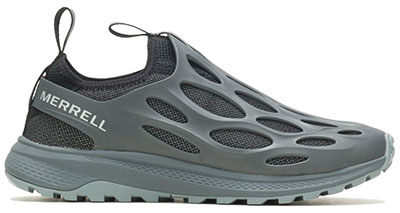
Upper Material: EVA
Sole: Rubber
Closure: Slip-on
Pros: Reflective for better visibility, foam liner provides added warmth
Cons: Takes a while to fully dry out
While there is never one shoe to rule them all, the Hydro Runners do a pretty darn good job of covering as many bases as possible.
The outsoles have enough traction to stay put in most situations, wet or dry. With a foam liner, we found these shoes to be ideal for situations involving chilly water. The construction isn’t neoprene but feels remarkably similar, and provides enough insulation to keep feet warm when wet. The result is that Hydro Runners are an excellent choice for shoulder-season adventures. As another bonus, the lining has reflective material to help you stay visible even if the rest of you is covered in mud from head to toe.
Check Price on AmazonTeva Original Universal ($55)
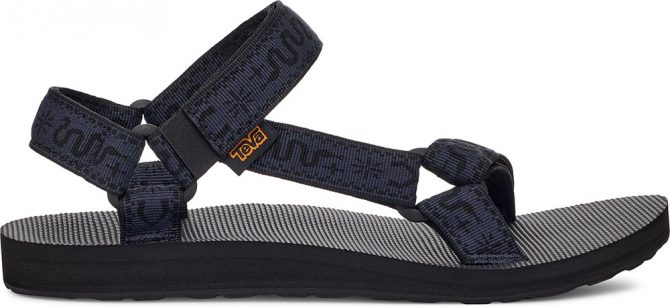
Upper Material: Recycled polyester
Sole: Rubber
Closure: Velcro strap
Pros: Stylish and versatile design, comfortable for all-day wear, suitable for various casual activities
Cons: Not ideal for intense water-based adventures, limited water resistance.
If you’re looking for water shoes that seamlessly blend fashion and functionality, you can’t go wrong with Teva’s Original Universal Sandals. With a stylish, versatile, time-tested design, they transition effortlessly from water activities to casual wear. That gives them added versatility over other water shoes we tested. With a thick spongey sole, they provide all-day comfort, making them suitable for leisurely walks, beach outings, and light water play. The straps are well-suited to keep the foot secure if needing to cross a river or handle uneven terrain. And the end-of-summer tan lines these provide are a badge of honor in some circles.
They are one of the classics for good reason — they work as they should and feel great. Read our full review of the Original Universals here.
Shop Men's on REI Shop Men's on Backcountry Shop Women's on REI
Xero Z-Trail EV ($80)
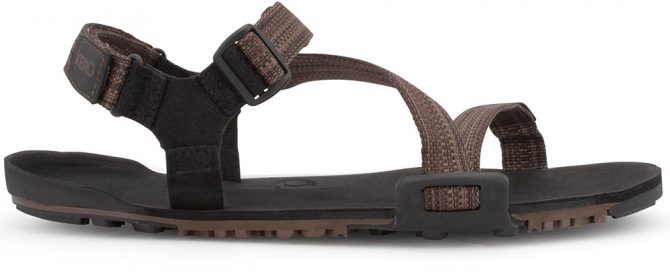
Upper Material: Polyester
Sole: Rubber
Closure: Strap
Pros: Almost as close as you can get to being barefoot while still having some protection underfoot
Cons: Thin sole might not be great on jagged rocks, a little floppy when swimming
For those who wish they could be barefoot but need protection underneath, here’s a great solution: Xero Z-Trail EV water shoes. These sandals boast a strap system that resembles Teva’s classic over-the-toe design. What sets them apart are the thin soles that still provide adequate traction but allow you to feel the surface you stand on. The natural response helps your brain navigate uneven terrain much more easily, according to Xero. Anecdotally, I found this also to be true — when walking on a rocky underwater coastline, I felt much more stable than while wearing thicker-soled options.
They aren’t great for heavy activity. But they are more stable than most sandals, thanks to the supportive straps. Speaking of straps, they don’t dry out super fast. That said, the soles were dry as soon as I got out of the water. If you like maximum foot freedom but the situation requires a little protection, these might be what you’re looking for.
But if you’re seeking even less under your sole, Xero’s Aqua Clouds takes the minimalism to the next level. They aren’t great for moving fast, but they are the next best thing to being barefoot while also protecting your precious feet from a rocky bottom.
Shop Men's on REI Shop Women's on REI
Astral Loyak ($95)
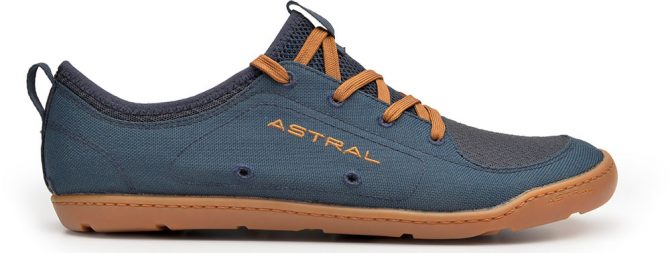
Upper Material: Canvas
Sole: Rubber
Closure: Laces
Pros: Looks like a regular shoe, has solid support
Cons: Laces could get caught on rocks, takes a while to fully dry
These were the first pair of Astral shoes that I’ve tried and I’m now a fan. They are comfortable and have great cushion and support, enough for me to feel good using these to work out or to up the activity meter to push myself. The Loyaks also happen to be some of the most “normal” looking water shoes we tested. I felt I could wear these shoes in a variety of situations beyond romping around in the water.
With a traditional lace system, they can get a good snug fit that lasts, whereas other water shoes with their stretchy material didn’t seem to work as well in that arena. The toes have drainage holes to get the water out quickly, but I will say that the drying time was much less than the “abnormal” looking water shoes with proper channels. Astral recommends removing the insole to dry them out. That definitely helps at the end of the day, but if you’re trudging around from the beach to the supermarket, that may get a bit annoying. Still, if you want a shoe that works well in town and underwater, this could be an ideal choice.
Shop Men's on REI Shop Men's on Backcountry Shop Women's on REI
VivoBarefoot Ultra III Bloom ($118)
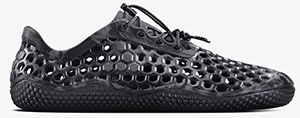
Upper Material: EVA
Sole: Rubber
Closure: Quick pull lace
Pros: Lightweight, thin yet durable sole
Cons: Sand gets stuck in the bottom
John John Florence spends a lot of time in the water. He also spends a lot of time on the water, cruising the ocean in his sailboat. So, for him to sign onto VivoBarefoot as a sponsor is a pretty big deal, considering he could probably just make his own brand and call it a day. But his partnership is a testament to the quality of craftsmanship that VivoBarefoot puts into its footwear, and the brand’s Ultra III Bloom shoes are no different. They allow for easy grip on wet surfaces and fast drainage.
They also sport a responsive, thin, barefoot-style outsole that allows your foot to respond to what’s underneath it. We loved this in most conditions. However, when the sand is soft, it does get stuck between the foot and the insole. This was true of most shoe-style water shoes that weren’t sandals, and you just have to accept that if you want the support of a shoe.
Best Water Shoes Comparison Table
| Water Shoes | Price | Upper Material | Sole | Closure System |
| Danner Rivercomber | $160 | Nylon | Vibram Rivercomber | Laces |
| Crocs Classic | $50 | Oil-based Croslite | Oil-based Croslite | Rubber heel strap |
| Hoka Hopara 2 | $150 | Cordura | Rubber | Speed laces |
| Xero Aqua X Sport | $130 | Polyurethane | Rubber | Speed laces |
| Kane Revive | $75 | Sugarcane-based foam | Sugarcane-based foam | Slip-on |
| Olukai Moku Pae | $120 | Engineered mesh | Rubber | No-tie laces |
| Native Jefferson Kids’ | $22 | EVA | Rubber | Slip-on |
| NRS Kicker | $58 | Neoprene | Rubber | Velcro |
| Merrell Hydro Runner 1TRL | $80 | EVA | Rubber | Slip-on |
| Teva Original Universal | $55 | Recycled polyester | Rubber | Velcro straps |
| Xero Z-Trail EV | $80 | Polyester | Rubber | Velcro straps |
| Astral Loyak | $95 | Canvas | Rubber | Laces |
| VivoBarefoot Ultra III Bloom | $118 | EVA | Rubber | Quick pull lace |
How We Tested Water Shoes
Steve Andrews took on the bulk of testing for this guide. The obvious way to test water shoes is — you guessed it — by wearing them in the water. But there’s a bit more to it than that. Water shoes are multifunctional tools. So, we exposed our testing models to any and all scenarios where water shoes could be of use. That covered everything from salt water to fresh water, moving water, rough rocks, smooth rocks, sand, and whatever else might be lying beneath the surface. We also brought them onto dry land to see and feel how they drain and dry — with and without the sun beating down overhead.

Water shoes need to perform well both above and below the water. Here, the Xero Aqua X Sports demonstrate good traction on solid ground. Photo: Steve Andrews//The Inertia
Comparing Water Shoes
Since the concept of water shoes spans a broad spectrum of footwear, it’s hard to make apples-to-apples comparisons. We took this into account when testing, focusing more on the specific characteristics of each shoe than on how well it stacked up against others.
We tested a wide variety and only listed what we felt was a worthy purchase. Our lead tester, Steve Andrews, wears a size ten men’s shoe with a medium-width foot. We didn’t comment on the fit too much since foot shapes vary so widely from person to person. But each of the water shoes we tested fit well, and none were too large or too snug.
To explore different categories of water shoes and the various uses for each, keep reading below.

Hoka’s original Hopara water shoes provided stability and support above and below the surface. Photo: Steve Andrews//The Inertia
Water Shoes Buyer’s Guide
Whether you’re planning a beach vacation, a hike with 27 stream crossings, or just looking for the best water shoes to keep your feet safe and comfortable, the ideal pair is out there. Here are several categories of water shoes and their unique features, uses, and who may benefit the most from them.
Water Sandals
Water sandals provide minimum protection but maximum breathability. They often have thinner soles, which may be problematic if you’re logging big miles. Support is also minimal, although within the category there are different strap styles. Flip-flops don’t count here. The key is for the sole of the sandal to remain close to the foot at all times with the use of a heel strap, helping to keep rocks from getting in between the insole and the bottom of your foot. The Teva Original Universal is a great example of a water-ready sandal.
Water Sneakers
Water sneakers are designed to look and feel like regular athletic shoes but are built with quick-drying, water-resistant materials. They’re great for more active pursuits such as water hiking or trail running in wet conditions. These are often the most comfortable options. But comfort comes at a cost. It takes that comfy material a bit longer to dry out! Drainage can be a key factor here. If you’re going in and out of the water often you’ll want something that drains easily, which is why some of the shoes in this category have a bit of a, shall we say, “unique” design. Our top pick, the Danner Rivercomber, is what we consider a water sneaker.

Shoes and swimming do go together, after all. Photo: Steve Andrews//The Inertia
Wet Shoes
These types of water shoes are meant to be worn underwater more often than not. The NRS Kicker are a great example. Some of them are even designed for swimming around. Often, they are form-fitting, so you don’t kick them off while swimming. They may also have neoprene to keep your feet warmer in colder water but aren’t as thick as a traditional wetsuit bootie.
What Are Water Shoes Best For?
Swimming and Snorkeling
Water shoes protect feet from sharp objects and rough surfaces, making them ideal for swimming or snorkeling. Those who frequently engage in these activities, especially in natural bodies of water, can greatly benefit from water shoes.
Water Sports
Being active near the water is a good enough reason to invest in a good pair of water shoes. Water shoes provide grip on slippery surfaces and protect the feet from potential injury. Water sneakers, in particular, offer the needed balance between protection, comfort, and style.

The rugged coastline of the PNW made for some excellent testing conditions. Photo: Steve Andrews//The Inertia
Hiking and Trekking
For individuals whose hikes take them into rainy environments or involve crossing streams and rivers, water shoes can provide better traction and help feet dry out quicker.
Keep in mind that choosing the best water shoes largely depends on your specific needs and the activities you plan to engage in. Understanding the various categories of water shoes and their uses can help you make an informed decision.
Key Features to Look For in Water Shoes
Whether you’re crossing rivers, hiking through wet terrain, or just looking to keep your feet safe and comfy, finding the best water shoes can enhance your adventure to the next level. Here’s what to keep an eye out for:
Material
Neoprene: Known for its excellent insulation properties, neoprene keeps your feet warm in cooler water. It’s flexible and fits snug, making it a great choice for swimming and other water sports. It’s a favorite of both surfers and river folks in situations where cold water immersion is inevitable.
Mesh: If breathability and quick drying are top priorities, mesh is the top choice. This material allows water to flow through easily, ensuring your shoes dry out faster and keep your feet comfortable during transitions between wet and dry environments.
Rubber Soles: Rubber soles provide excellent traction on wet and slippery surfaces. They also shield your feet from sharp objects like rocks and shells, which is crucial for both hiking and beach activities. Premium models (like Danner’s Rivercomber) offer Vibram outsoles that can do well on land as well as slippery surfaces underwater.
Drainage System
Built-in Drainage Ports: Shoes with drainage holes or channels allow water to escape quickly, preventing them from becoming heavy and waterlogged. This feature is especially important if you’re frequently in and out of the water.
Quick-Dry Linings: Some water shoes come with linings that wick moisture away and speed up the drying process, keeping your feet dry and comfortable.
Comfort and Fit
Snug Fit: A good pair of water shoes should fit like a glove—secure but not too tight. This prevents blisters and ensures your feet stay comfortable, even during extended wear.
Adjustable Straps: Features like adjustable straps or bungee laces allow you to customize the fit for added security and comfort.
Cushioned Insoles: Look for shoes with cushioned insoles that provide extra support and comfort, which is essential if you’re planning on wearing them for long periods.

Danner’s Rivercomber was a top pick thanks to their comfort, traction, and quick-drying capabilities. Photo: Steve Andrews//The Inertia
Durability
Quality Stitching: Reinforced stitching in high-stress areas ensures your water shoes hold up under tough conditions.
Sturdy Materials: Choose shoes made from high-quality neoprene, mesh, and rubber to withstand rugged use.
Protective Toe Caps: Reinforced toe caps protect your toes from impacts and abrasions, adding an extra layer of durability.
Traction
Non-Slip Soles: Opt for shoes with non-slip rubber soles that provide excellent grip on wet and slippery surfaces. This is crucial for safety, especially when navigating rocky or uneven terrain.
Tread Patterns: Shoes with aggressive tread patterns offer better traction and stability, beneficial for hiking and other outdoor activities.
Weight
Lightweight Design: Lightweight shoes are more comfortable for long-term wear and won’t weigh you down in the water. Look for a balance between durability and weight.
Final Thoughts
Choosing the best water shoes largely depends on your specific needs and the activities you plan to engage in. Understanding the various categories of water shoes and their uses can help you make an informed decision. With the right pair of water shoes, you’ll be ready to tackle any water adventure comfortably and safely.
Editor’s Note: Looking for women’s options? Check out The Best Women’s Water Shoes. And if your adventures are a little more terrestrial, peep The Best Hiking Boots. For more gear reviews and features on The Inertia, click here.



